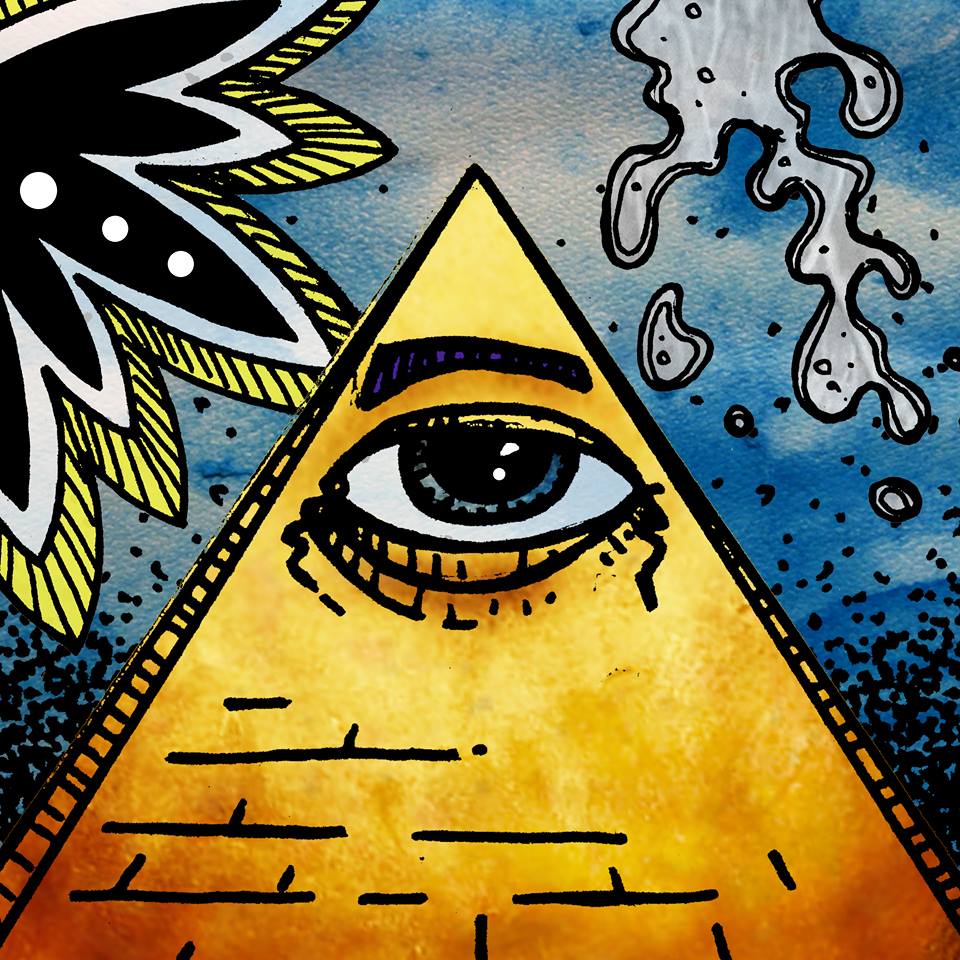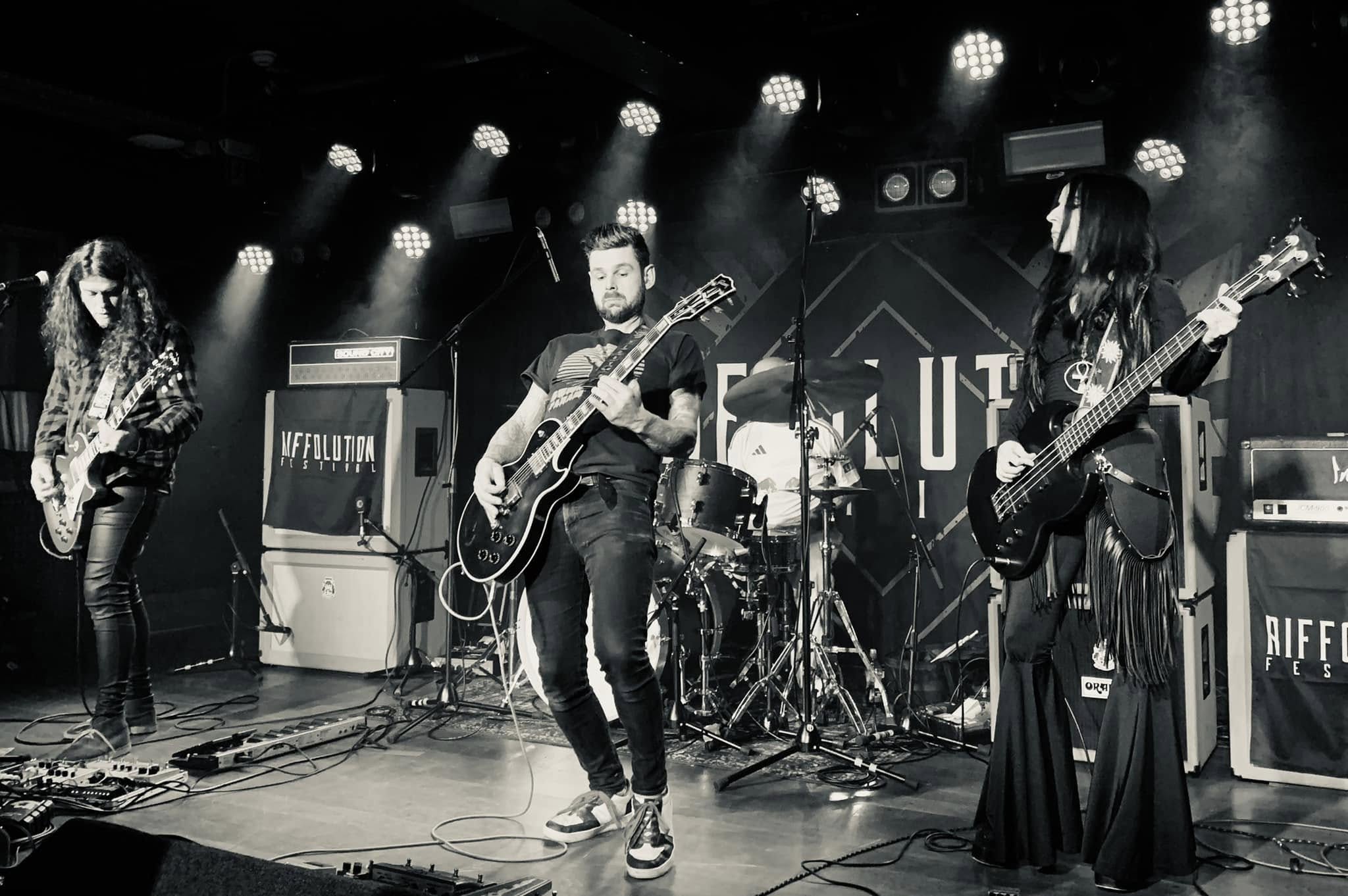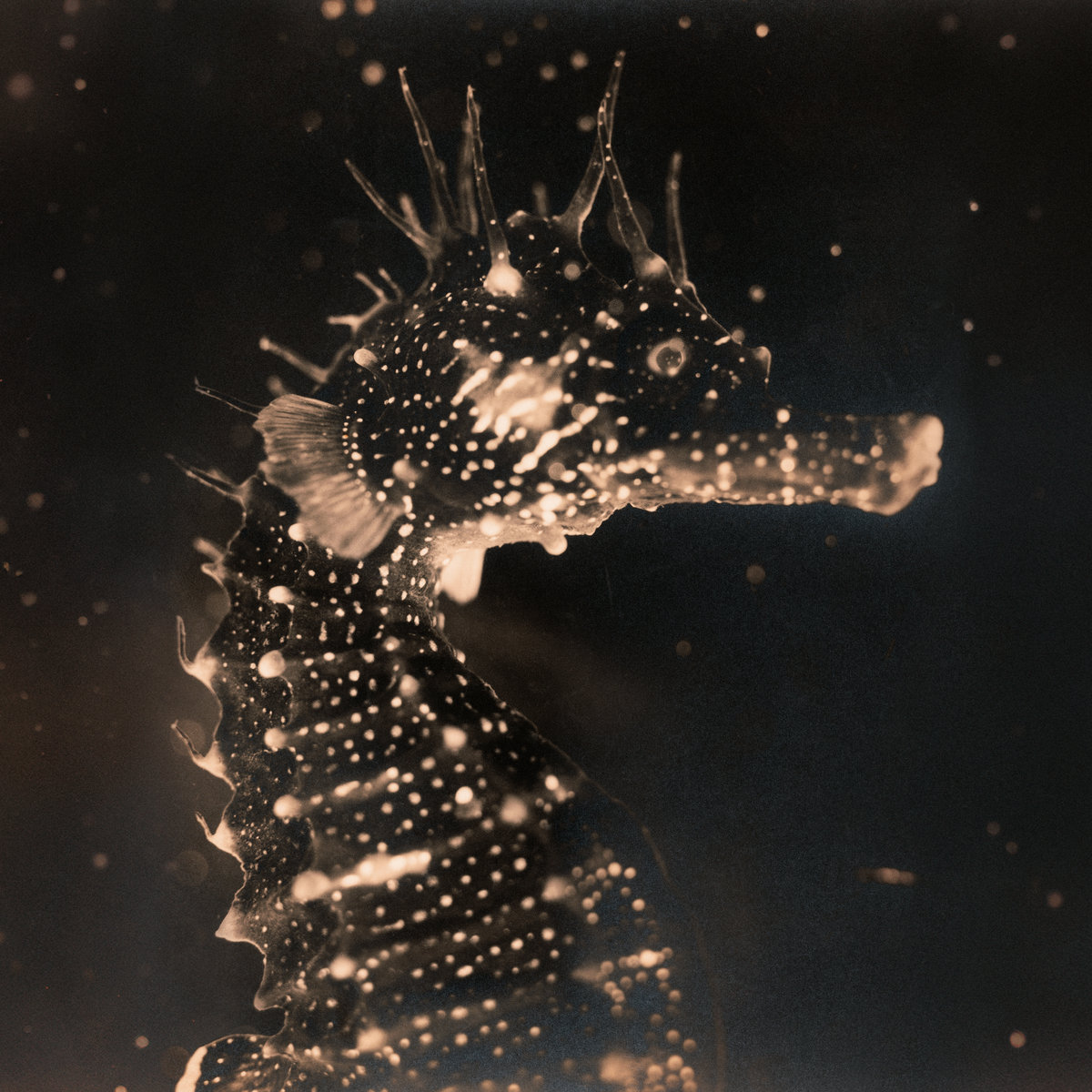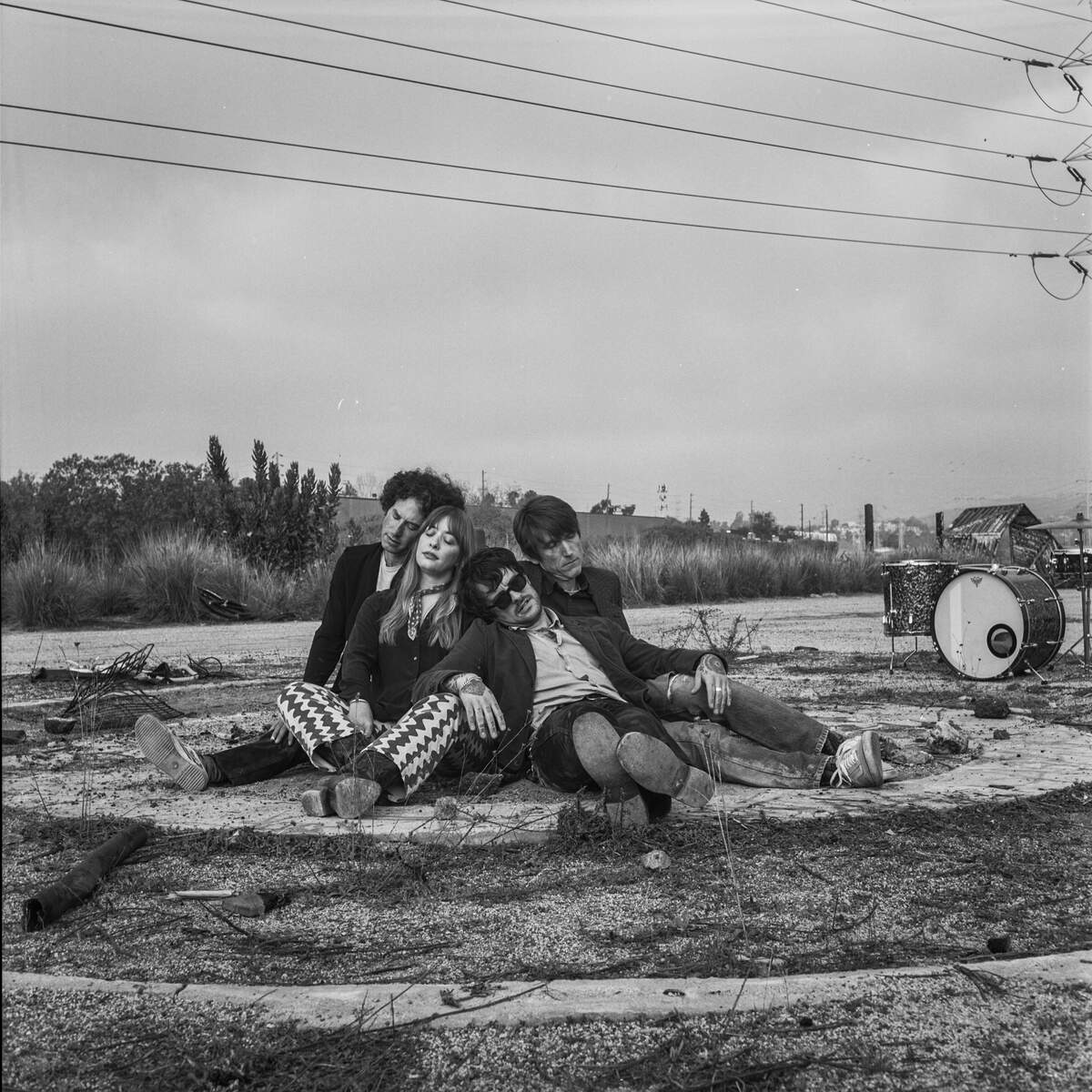Amon Acid | Interview | New Album, ‘Submerging’
Amon Acid’s latest album, ‘Submerging,’ blends occult, hypnotic, doom-infused grooves with subtle hints of traditional Greek rhythms and gothic ambience – very unique at that.
The record itself marks a significant evolution, as the group shifts from a duo with guest musicians to a fully-fledged band. Recorded in a mix of spare bedrooms and DIY studios, ‘Submerging’ truly embodies the underground spirit that has always defined Amon Acid. Tracks like ‘Toad Venom’ and ‘Tetrahydron’ capture the band’s knack for merging diverse influences—from dub to psychedelia—into a seamless, exploratory journey. Using vintage gear such as an SG-style bass and an effects pedal known as the Koko Phaser, the band creates their own “Acid” sound. Spinning the platter reveals layers of spontaneity and dark mysticism… it’s great and refreshing to see a band sticking to their punk/DIY roots.
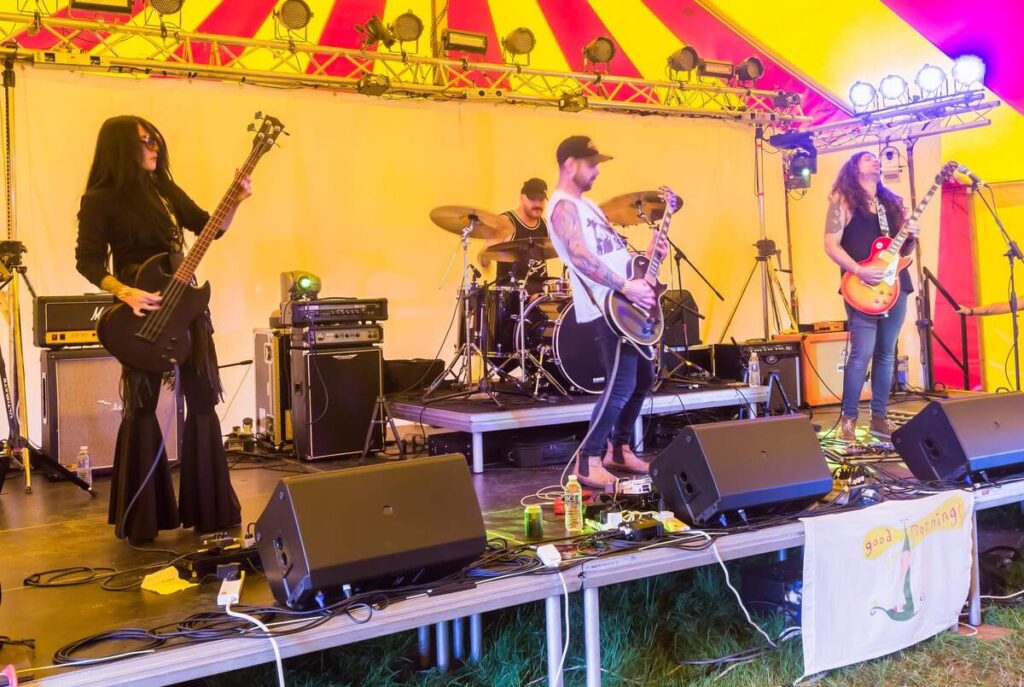
“I think the main common thread that links us all is punk”
First off, tell us about yourselves. How’d you get into the chaos of music? Were you in any other bands before Amon Acid came to life?
Amon Acid: As a band, we have a very mixed musical background. I think the main common thread that links us all is punk, and we all met vaguely through links in that scene.
Briony: I grew up in a tiny village in East Yorkshire in the UK. There weren’t many opportunities to start a band, but I spent my youth at nu-metal gigs and underground techno raves. I was always very impulsive and too hedonistic to really focus on artistic pursuits. When I left home, I bought a cello and eventually got my shit together enough to start a solo noise/experimental project (Aghartha). I met some really inspiring artists during this time, but I never felt free enough to really chase my musical aspirations. I was tied down by studying, and I still feel like I live a double life split between science and music.
Through the years, I have occasionally played with my friends Layla and Phil Legard in wyrd acid folk/experimental bands like the Institute of Stoneage Sex, Solis Noctus, and Hawthonn. This gave me a lot of joy and boosted my confidence to pursue starting a band, but the stars never aligned until I met Sarantis.
Sarantis: My dad was a musician in Greece (Periklis Harvas—his first album was recently reissued by B-Other Side Records). I grew up with music around me all the time, from rock and metal to traditional Greek folk, reggae, and soul. My dad was really open-minded, and he switched me on to so many influences before he died in 1993.
I played with a few bands in Athens, then came to England in 1999, where I played in a couple of punk bands that never released anything. The longest-running band I was in was an instrumental surf band called Los Pecadores, which came out of the squat punk scene in Leeds at the time. After a few attempts to start a psych/stoner doom band over the years, I started a doom metal band, Outer Head, just before Amon Acid, which I’ve been playing with until recently.
John: The photo of me is from when I was singing with Canvas at the Occhi in Amsterdam. I remember it like it was yesterday, but I was 19 or 20 at the time.
Will: I played there. Great place. I remember the huge carved wooden door at the front.
I probably got into music around age four when I first heard Pink Floyd, and it terrified me. All the spooky laughter and odd vibes on ‘DSOTM’ were really unsettling for a little kid. Then, when I heard Nirvana at 12, I decided to start playing guitar. I found an old beat-up 12-string acoustic with a snapped neck that could only handle six strings because it was crudely bolted back together.
I’ve been in lots of bands since. Some better than others. A few are still going, some are on hold, and some are gone forever.

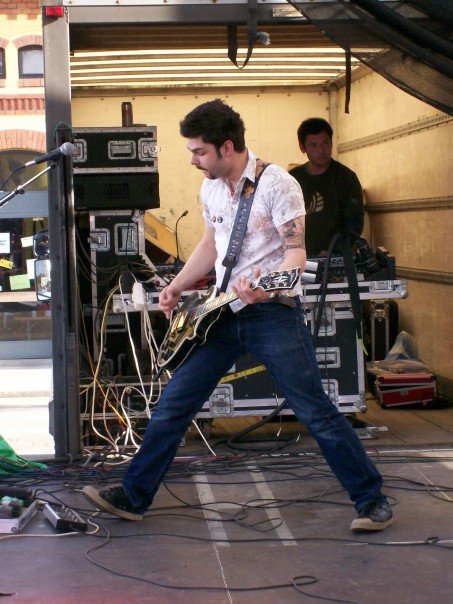
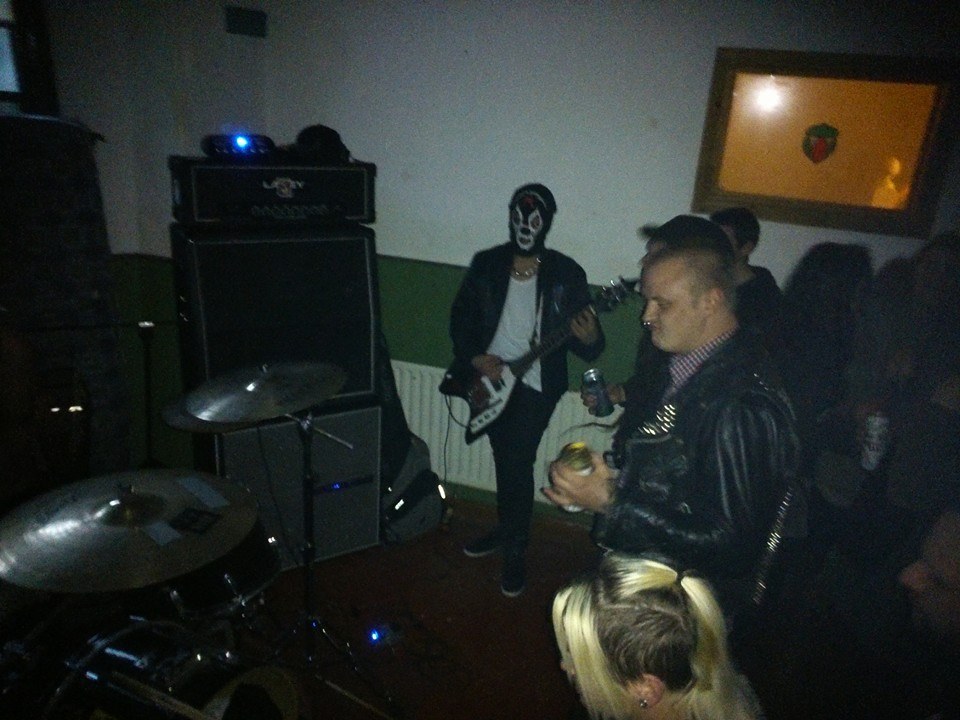
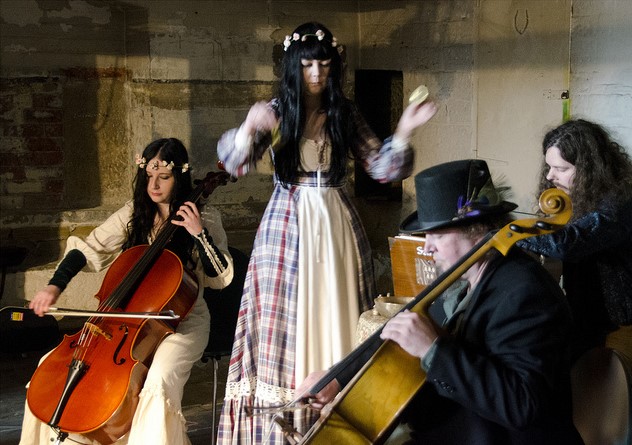
How’d you all cross paths? What was the spark that got Amon Acid rolling?
Briony: I met John in Hamburg around 2016 when he was touring with the punk band Natterers. When I moved back to the UK, I finally met Sarantis. I’d seen him play with Los Pecadores in Leeds years before—we had mutual friends—but when we finally met, we hit it off and pretty much instantly decided to start a band. I really wanted to learn how to play bass, so we started jamming as he taught me. Amon Acid was formed in our spare bedroom with a drum machine, a guitar-to-MIDI synth, and a lot of experimentation.
We were playing around with different ways of making sounds, using lots of overdubbing on recordings. John was putting on gigs in Leeds at the time and asked us to play, but we weren’t really able to do anything live yet, so Sarantis’ band, Outer Head, played instead. Sascha from Aumega Project noticed us pretty much from the beginning, and he really helped us stay motivated and spread the word.
Around this time, I saw that Acid Mothers Temple were coming to Leeds, so I contacted their booking agent (without telling Sarantis) to see if we could support them. Surprisingly, they said yes. So then we had to quickly figure out how to do everything live. We roped in an old friend to play second guitar—it went surprisingly well, but I was literally shaking on stage, playing in front of one of my favorite bands.
During lockdown, we spent most of our time at home jamming and recording. Looking back, it was a beautiful time. We were asked to play the Shindig! online festival (I think it was the first-ever online festival?), and through that, we met Magick Brother & Mystic Sister, who we still keep in touch with (their new ‘Tarot’ diptych is a masterpiece). Mario from THC-Kombinat contacted us to put ‘PSI’ out on CD. After that, we were trying to find a label to release more of our music, but no one seemed interested, so we just kept doing our thing and releasing music as we went along.
After we released ‘Paradigm Shift,’ Per from Regain Records reached out and wanted to put it on vinyl—he took a chance on us, and we’re forever grateful for that. He suggested we try to find a live drummer for our next album, but that wasn’t easy during lockdown. We’d already asked John, but he was busy with his band Calm and had a new baby on the way. Since everything had to be recorded remotely anyway, we asked our friend Smith (Afternoon Gentlemen, Exorbitant Prices Must Diminish). He had moved to Switzerland but did an amazing job recording the drums for Cosmogony to stems in his practice space—’Incredible Melting Man’ is a nod to his D-beat roots.
When things opened up after COVID, we asked John to play drums again, and he finally agreed. I put on a few gigs as Acid Road Promotions in Leeds—mainly as a shameless way of playing with some of our favorite bands. I never realized how exhausting promoting was when I started, and I’ve more or less stepped back from that now, but it was an amazing experience.
That’s around the time we met Will. We were invited to Idlefest (a local pub festival organized by Phil from Psychlona), and Will’s other band, Dead Monarchs, was playing. We had been thinking of finding a second guitarist to make life easier for Sarantis. We waited until he came to another one of our gigs and asked him to join—luckily for us, he said yes pretty much immediately. Thankfully, Will is very good at balancing his obligations and manages to be in three bands at the same time without any issues!
We’ve been lucky to play some great venues around the UK, but a couple of highlights have been In a Nutshell at Fellfoot Wood in the Lake District and Kozfest. They’re both small, intimate festivals run by true legends of the UK’s psychedelic underground, and through them, we’ve met lifelong friends.
“All of our albums are linked together by an underlying philosophy”
Right, but was there a specific vibe or concept you had in mind from the jump, or did it all just kind of fall into place?
All of our albums are linked together by an underlying philosophy that has gradually developed over the years, which we articulate through sonic landscapes. The idea of East and West percolates through everything in our lives. Global politics, art, music, and language are shaped by imaginary borders, but digging a little beneath the surface reveals the threads woven through music and art that reflect a common human experience. Driven by pain and joy, creation and destruction in equal measures, we are citizens of the world.
Sarantis and I met after some pretty dark times but instantly connected through music. In the early days, he introduced me to Rembetiko, which is like the Greek blues. I think when you’ve grown up around a particular style of folk music, you can sometimes take it for granted, especially the kind of music you learn to play in school. But to me, it was fresh and exciting. I encouraged him to incorporate that into what we were playing. At the time, we said something along the lines of, “If it’s trippy, anything goes.” We were playing music for our own enjoyment—it really didn’t matter where the influences came from as long as they were broadly psychedelic. From there, through researching the roots of music, we made various discoveries. This summer, we were listening to a lot of Ipirotiko but also rediscovering the Butthole Surfers. Our influences are always woven into the music, but since John and Will joined the band, we’ve definitely moved toward the heavier side of psychedelia.
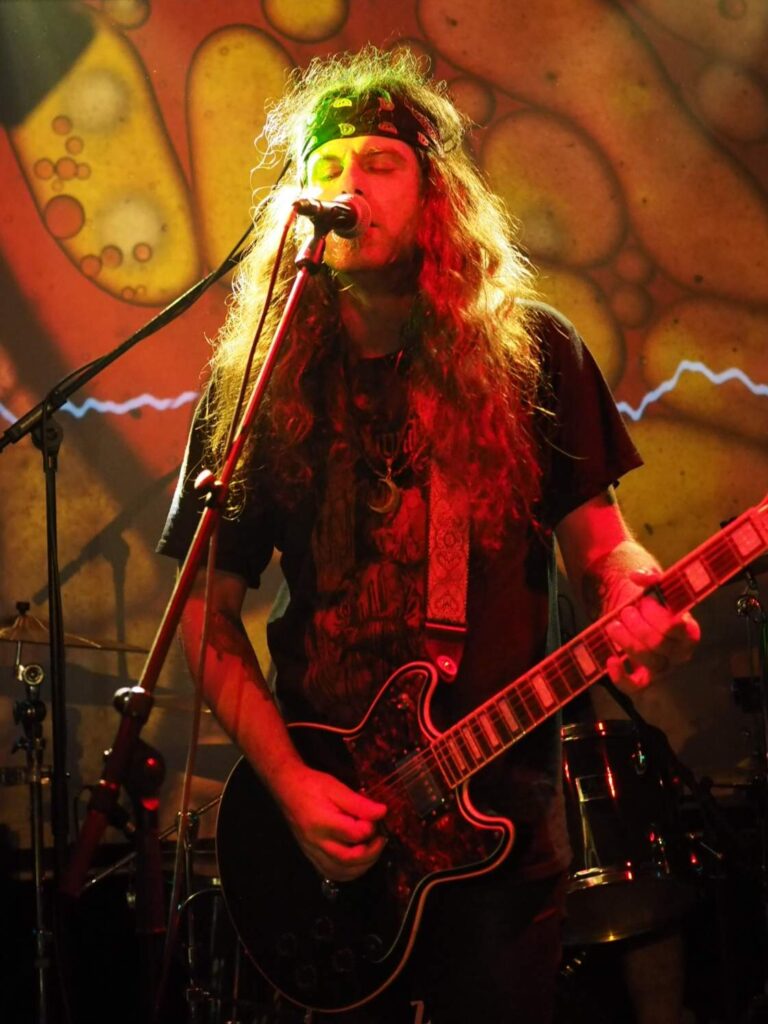
You’ve only been around for a couple of years, but there’s already a stack of albums. Walk us through each one—what’s the story behind each record, and how did they come together?
The first EP was us finding our feet, but listening back, it’s not that far off from where we are now. ‘Doumani’ is pretty representative of our sound—it means “thick smoke” in Greek, which kind of sums things up. We like repetitive, hypnotic grooves and layering different sounds and effects over them to create a psychedelic-infused trip. ‘Edge of the Universe’ is more upbeat psych than our newer stuff. We haven’t listened to this for years—it’s weird listening back. This is pretty fun stuff. It could be mixed better, but Sarantis did his best with this EP with limited tools at home!
‘Slow Burn’ is heavily influenced by Memphis rap like Tommy Wright III, Spanish Fly, and Triple 6 Mafia. The link between prog rock and hip-hop is a straight line, and I really love using the drum machine with live guitars for this reason—as above, so below.
‘Burial’ reminds me of Geoff Krozier, and I think we had just discovered his music around this time—so, heavily influenced, but I can’t find the specific song online anymore.
We recorded and released ‘Amanesh’ immediately after the EP, and we were taking things more seriously by this point. The title Amanesh is a play on amanes, a style of Greek lament or love song. “Aman aman” is a poetic phrase that means something like “mercy!” It is deeply intertwined with Turkish music, and we were listening to a lot of Anatolian rock bands like Erkin Koray and Selda, as well as Rembetiko artists like Marika Papagika, Roza Eskenazi, and Giorgos Batis. These influences led things to take a darker turn, and we also brought in more occult references in this album. We still play ‘Aman Ariman’ live—it’s a continuation of the theme we started with ‘Doumani.’ We want to record a live version of this track because it has evolved with live drums, but we definitely shaped our sound around this. The bass in ‘Turn to Stone’ is influenced by dub, which is something else that is subtly woven through all of our albums—the link between dub and early goth was at the forefront of our thinking around this time. ‘Bare Witness’ and ‘Abstract Space’ are definitely more Geoff Krozier/Arthur Brown-inspired tracks again, but with hip-hop influences in there too. ‘Abstract Space’ is a sign of things to come—the fuzzy stoner doom sound is starting to emerge here. ‘Synaptic Flow’ and ‘Wonderland’ are really dancey—they definitely lighten the mood, bringing in some electro-punk influences. I really enjoyed playing this track. We’re recording some faster tunes at the moment and would like to pick up this thread again at some point.
‘Leftover Acid’ is a bunch of tracks we recorded at the same time as PSI. We weren’t really sure what we wanted the next album to sound like, but we were listening to a lot of Anatolian, Lollywood/Bollywood, Choubi’ and Dabke music at this point in time. In the end, we decided we wanted the next album to be more on the rock side, so we put these tracks out as an EP. This style evolved into a side project Belalis.
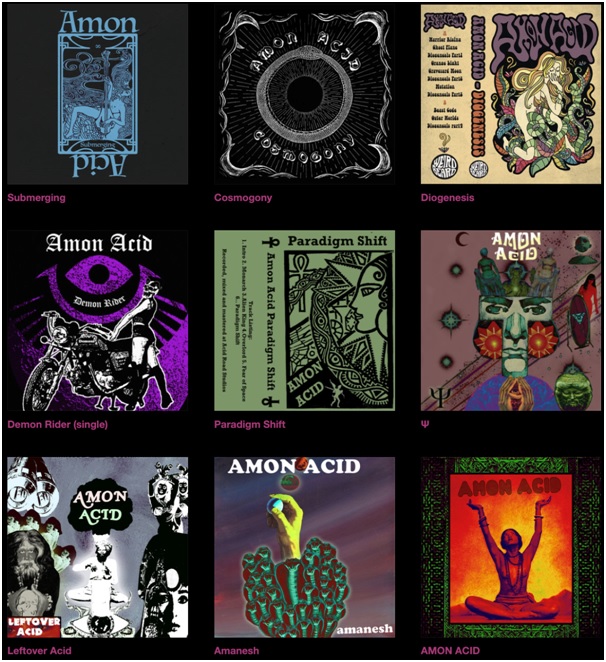
‘PSI’ has been described as space rock world music, and we were delving deeper into Middle Eastern music at this time. The first song was a cover of ‘Kegome’ from Rebetiko—it’s no longer on Bandcamp because we got sent a cease and desist, something to do with soundtrack music not having the same rules about covers. Whatever the reason, we felt very important that anyone other than us had heard our music! We were living in a part of Leeds with a large Kurdish population and used to chat with a local shopkeeper about music—Hasan Zirak and Gulistan Perwer were getting a lot of airtime at home around this time. In ‘Caravan,’ the phrase “Yallah Yallah” is again shared throughout the Middle East and Greece, meaning something like “come on!” (Weirdly, Will is also in a band called The Yalla Yallas.) My parents gave us ‘Mirage’ by Camel and ‘Aqualung’ by Jethro Tull for Christmas, and we finally admitted to ourselves that we actually did enjoy prog rock—overcoming some inbuilt rebellion against the music our parents listened to.
‘Paradigm Shift’ is when we really embedded a doomier sound into our music. We were deep in lockdown by the time we recorded it in our spare bedroom. I think of this album and remember feelings of total love and absolute despair. We had bands like Mephistofeles, Salem’s Pot, and Om on heavy rotation at this time. It’s really a reflection of the times we were living in. Monarch is laden with innuendo, but the rest of the album is more serious than our previous releases. ‘Fear of Space’ has a grime/Memphis influence that was pretty cathartic to play. This, along with ‘Overlord,’ was written during some particularly dark times—a lot of trauma was seeping through the cracks at this point. I think ‘Paradigm Shift’ was an attempt to make sense of where we were individually in a world that changed overnight.
‘Cosmogony’ was originally recorded with a drum machine. We then sent it over to Smith in Switzerland, who recorded the drum parts. We then re-recorded everything over the drums—it was hard work, but we feel like it paid off in the end. ‘Cosmogony’ is about the birth of the Amon Acid Universe, a concept that took a double LP to realize. The full story is for the initiated (it’s printed on the album cover). We dove headfirst into our version of psychedelic doom at this point. I asked my friend Cookie (Folie Art and Design, Gurnal Gadaffi) to design the cover, and she really captured the atmosphere of the music in her artwork. We finished recording ‘Cosmogony’ around the time vinyl pressing plants were struggling to keep up with demand, so the release took a lot longer than expected.
In the meantime, Sarantis had an idea to record a soundtrack for a sci-fi horror film, ‘Diogenesis.’ This is a homage to Giallo films and inspired by Goblin. Weird Beard released it on cassette, and one of our favorite artists, Shane Horror, designed the cover. I love everything about this album, although I contributed very little—a few bass lines and a tiny bit of cello. This was a labor of love for Sarantis. I like the idea of having weird, left-field releases in between our full albums.
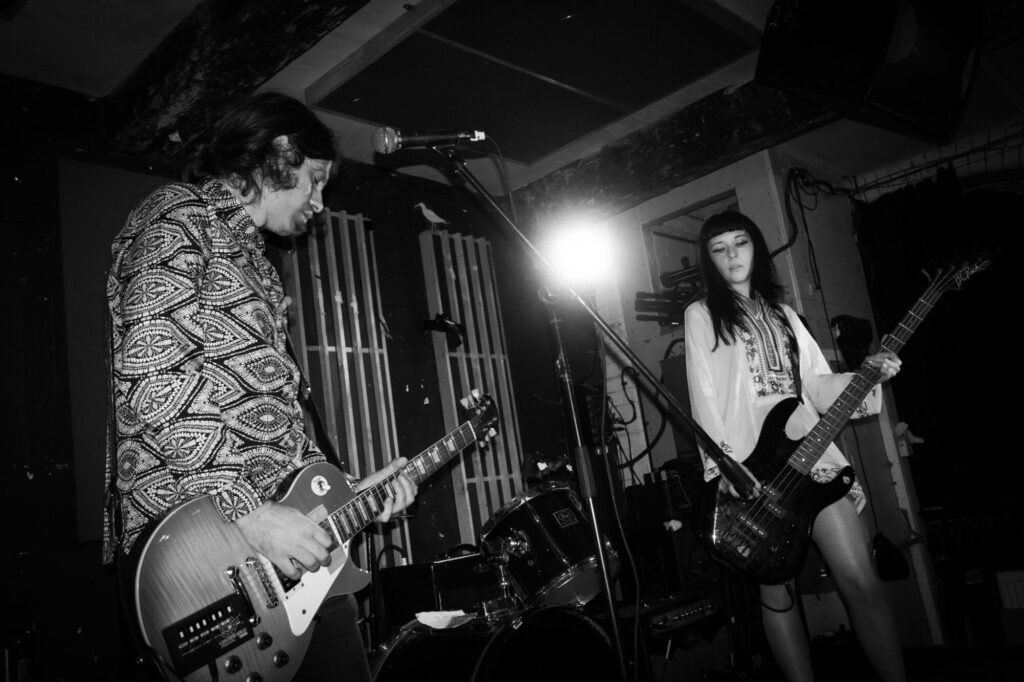
So your latest record ‘Submerging’ just dropped. What’s the deal with this one? What makes it stand out compared to your past work?
‘Submerging’ is the first album we recorded with John, and because of that, it represents a shift from us being a duo with guest musicians to a fully-fledged band. ‘Toad Venom’ is a goth take on zebekiko. Before we recorded this album, I was given an SG-style bass made by my friend Neil (Batsford Bass). He’s a huge Bauhaus fan, and talking to him got us re-listening to ‘Burning from the Inside.’ We were interested in playing with the traditional 9/8 time signature.
‘Tetrahydron’ was written as a jam, something that is much easier with a live drummer. We were trying to find the connections between completely disparate genres we like and throw them together in a jam—starting with a very simple riff that could even be a dub riff, but when it’s played heavy, it sounds like Dio. Then we brought in traditional Greek motifs over it. There is a prog element to this one, and I think that’s where John’s influences shine through. The length may be off-putting to some, but I think what’s evident in everything we do is that it’s always changing and doesn’t appeal to everyone.
‘Submerging’ was released by Black Farm Records, and Thomas was really accommodating with our wish to release an Amon Acid tarot alongside the album. This had been a lifelong goal of mine and is dedicated to an old friend, Fred Gettings, who wrote ‘The Book of Tarot’ in 1973. He taught me a lot about symbolism, creativity, and duality. The tarot is a retrospective of all of our albums and took a long time to complete, eventually leading to a delay in the release of ‘Submerging,’ so I owe Thomas a great deal for his patience and support.
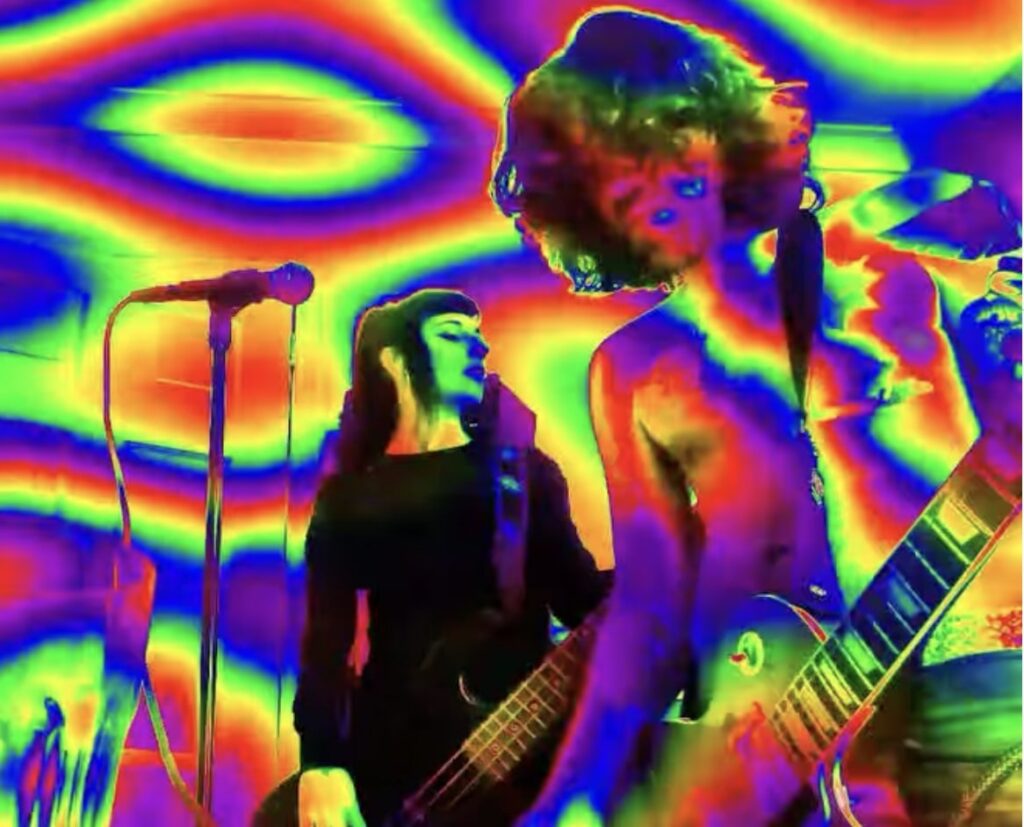
Any plans to hit the road and wreck some venues soon?
We’re taking a little break from playing live to record our next album early in 2025. However, we have a couple of festivals lined up: North West Doom Fest on April 4th & 5th in Chester, organized by our friends Warlock Hunt.
In the summer, we’re really excited about the Conjuring Festival (link), organized in part by Jack from The Dirt. It’s in the beautiful Pealie’s Barn in Richmond, North Yorkshire, from August 15th to 17th.
Then there’s Cosmic Vibrations festival in Sheffield at the end of August. This one has grown really quickly, and Danny from Lloyd’s Trip has been working hard promoting festivals and concerts over in Sheffield.
We’re also looking for dates in Europe, but nothing is solid yet.
Before we wrap this up, let’s talk gear—what are you guys playing on? Any weird or wild stuff you swear by?
The Koko Phaser—a pedal we picked up for £15 online—has featured on all of our recordings! We decided to put it on the bass on ‘Toad Venom,’ and it has a really swampy quality. I don’t think I’ll let it go now.
Sarantis plays the Tzouras (a small bouzouki) on many of the recordings, and it will feature on the next album. It was bought as a wedding gift, and it’s small enough to travel with, making it easy to keep on hand when inspiration appears.
For synths, everything is played live using the guitar and a MIDI foot pedal. We have a dub siren, which is now part of our trademark sound, but we’ve also incorporated lots of weird little sound makers over the years, including a Buddha Box and a National Instruments signal generator.
When we started, we used a free guitar-to-MIDI plug-in through the laptop. However, relying on a laptop is pretty nerve-wracking when playing concerts, so we invested in a Boss SY-300. It has three oscillators triggered by the guitar, and you can design sounds like on a traditional synth (LFO, waveforms, arpeggiator, etc.). It’s the only synth pedal we’ve tried that does what you ask convincingly—but the presets are terrible, so it has gone under the radar for a lot of people. Sarantis has written songs just from messing around and creating sounds with it.
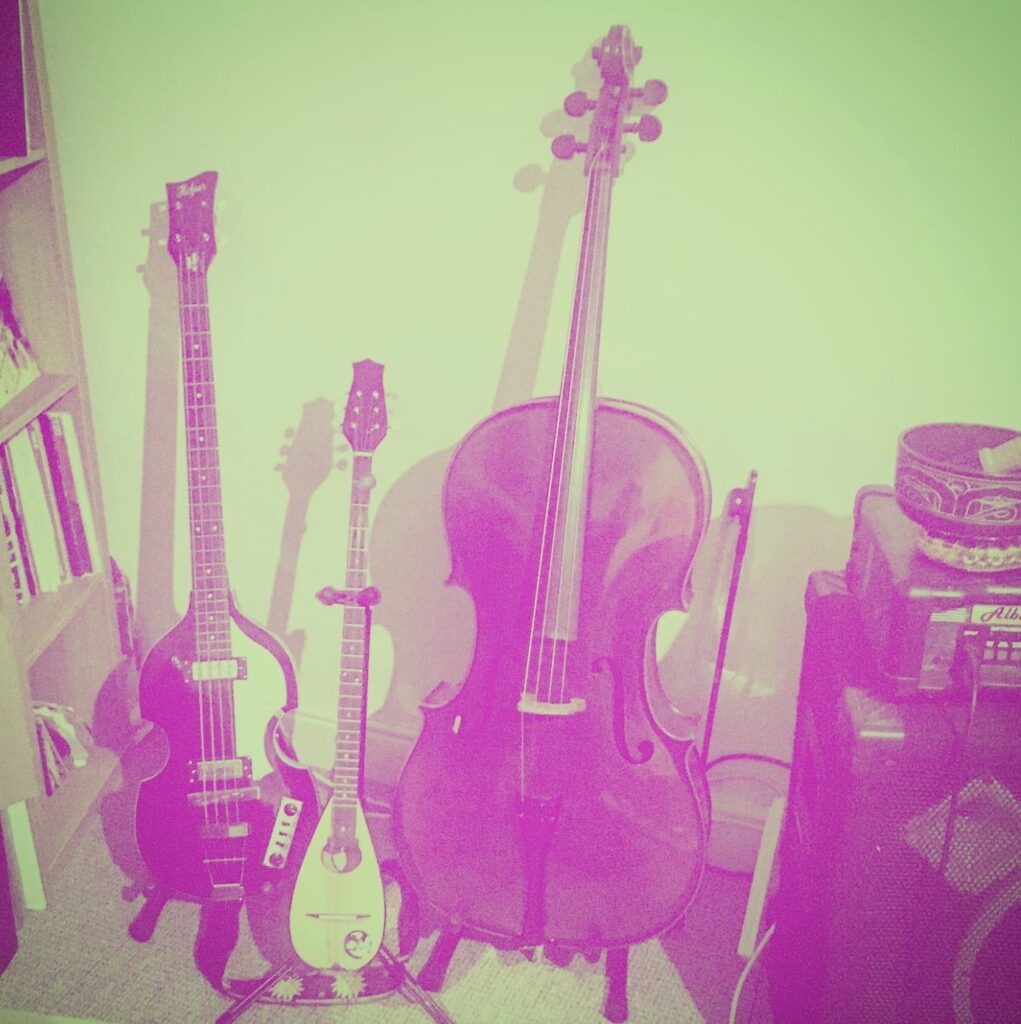
To end on a high note, what are you all listening to these days? Anything fresh you think our readers should be cranking up?
We’ve been listening to a lot of folk music from Iperos recently—’Panta S’ Agapousa’ has been a particular highlight.
In the past year, we got really spooked about listening to new music due to the emergence of AI. We have very big feelings about the dark forces that are developing and controlling these hallucinatory beings.
The Asimov / ACID ACID split, released in 2024, is kind of doomy and garage-y, and they really hit a psych sweet spot for us. Asimov are totally underrated in our opinion—we were lucky enough to pick up a copy of ‘Algures No Mundo É Noite’ at Sound Effects Records in Athens a couple of years ago.
We’ve already mentioned Magick Brother & Mystic Sister—their tarot release came out just before ‘Submerging.’ Synchronicity, maybe? We’re trying to get them over to the UK; time will tell!
Tristwch Y Fenywod’s debut also came out this year, and it has been a joy to listen to. We feel very connected to their approach to goth.
Codex Serafini’s ‘The Imprecation of Anima’ was released in 2023, but these guys have been killing it live this year. We love their unique and chaotic approach to psych.
Gnob’s ‘Gnob II,’ also from 2023, is a stoned-heavy psychedelic journey. We love those guys.
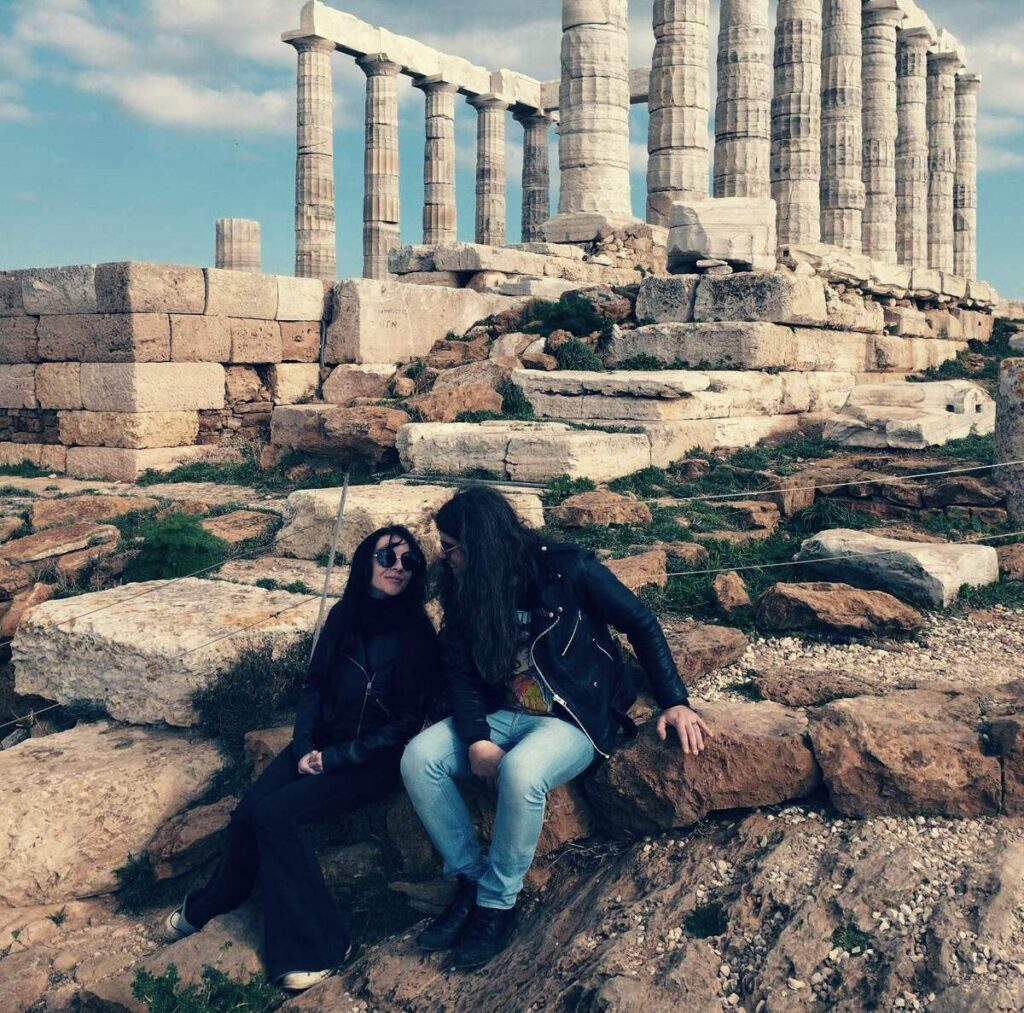
Thanks for hanging with us. Anything you wanna say to close it out?
Keep on trippin’!
Klemen Breznikar
Amon Acid Website / Facebook / Instagram / YouTube / Bandcamp
